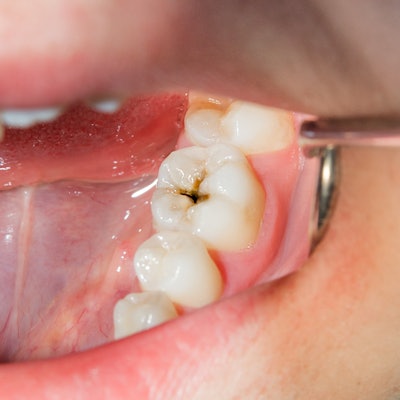
Silver diamine fluoride (SDF) therapy is an effective and efficient treatment for early childhood caries, but the resulting permanent black tooth staining is a top concern for parents considering its use for their children, according to a study that is being published in the October issue of the Journal of Dentistry.
Although oral health knowledge has generally improved, early childhood caries remain a global issue. Untreated caries can progress into the dental pulp, causing pain and infection. Aside from impacting children's oral health, untreated caries can also influence children's nutrition intake, cognitive development, general health, and quality of life.
Conventional treatment for childhood caries can be difficult, as young children may be uncooperative with complex and invasive treatment, and SDF has been touted as an effective, safe, and cost-effective alternative.
"Alternative treatment, which is simple and non-invasive, should be adopted to manage early childhood caries," wrote the study's authors, led by Dr. Hollis Haotian Chai of Xiamen University in China (J Dentistry, October 2022, Vol. 125, 104250).
The study explored parental perspectives on an outreach dental service and SDF therapy to prevent early childhood cavities. It was conducted in collaboration with an outreach service offering SDF therapy to children in kindergarten and oral health education to the children's parents. Five parents were recruited from each kindergarten for a focus group discussion.
Ten focus group discussions with nearly 50 parents were held. The discussions included parents who consented and did not consent to SDF therapy on their children.
The black staining following treatment was a major concern of the parents. Some parents believed that the staining would negatively affect their child's appearance and self-image.
Other parents expressed concern that they would be blamed by others for their children's stained teeth. Researchers speculated that this may be related to the perception of the black staining as severe dental caries. In addition, some parents said they were worried about the toxicity of SDF.
Despite their concerns, 80% of parents accepted SDF treatment for their children. Effective communication detailing SDF treatment could increase parental acceptance. When considering whether their child should undergo SDF therapy, parents prioritized their understanding of and confidence in treatment as well as the potential benefits.
This study found that the outreach dental service using SDF to treat childhood cavities is an adequate strategy from the parents' perspective. The parents preferred the treatment of caries over aesthetics and accepted SDF therapy. The study's results provide multidimensional information about parents' experiences and opinions of SDF therapy in outreach dental services.
"Dentists can use the arguments from this study to form a protocol for communicating with parents before SDF therapy," Chai and colleagues concluded.



















